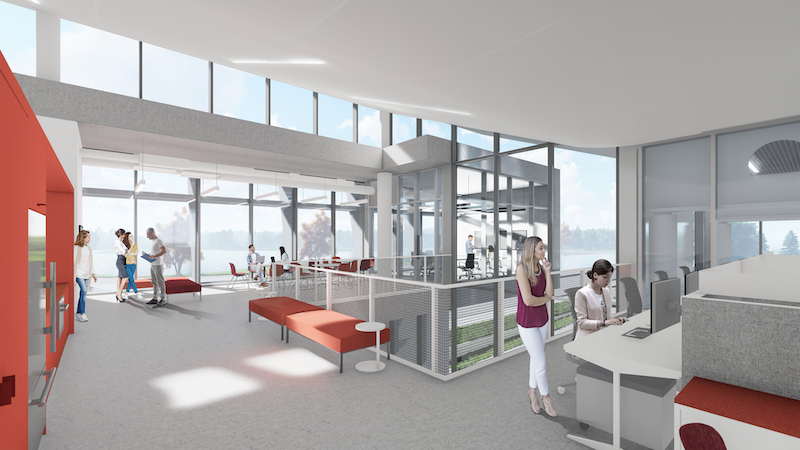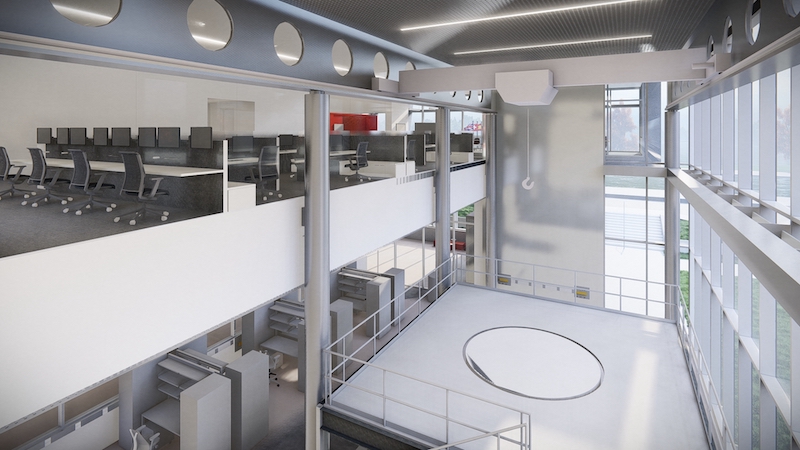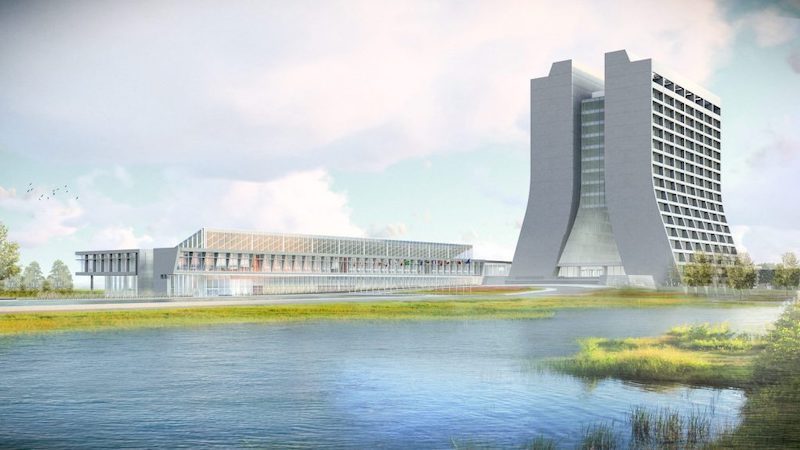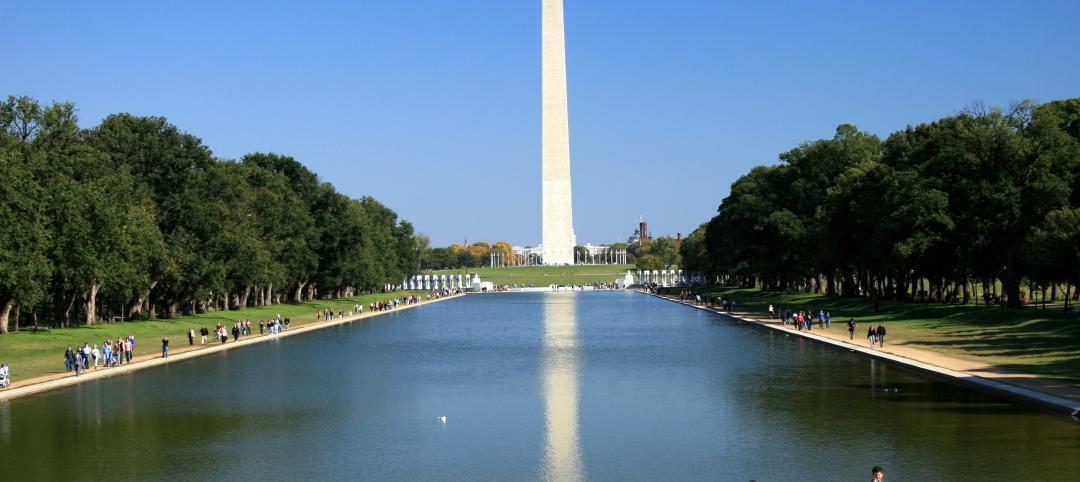This fall, construction is scheduled to begin on the Integrated Engineering Research Center (IERC), an $86 million, 85,000-sf infrastructure project on the 6,800-acre campus of the Fermi National Accelerator Laboratory in Batavia, Ill., the nation’s premier particle physics lab.
IERC has been in the works since the summer of 2015, and at one time was conceived as a 100,000-sf building that dedicated two of its three floors to office space. That concept changed after a team comprised of Arup and Perkins and Will won a design competition that Fermilab conducted in 2017.
That team’s concept scales back the building to two floors, and includes more lab space. What emerges are “hybrid labs” that, essentially, remove the walls separating labs and offices for the purposes of colocation and collaboration. There are two hybrid zones on the ground floor, in one big open area “that just about anyone can walk through,” explains Aaron Tabares, a Senior Electrical Engineer for Arup’s offices in Chicago, which provides the SE, MEP, F/LS, AV, and IT services to the IERC project.
(He notes, parenthetically, that Arup’s acoustics expertise came in handy to help design these hybrids with quiet features for researchers when needed.)
Brian Rubik, SE, Fermilab’s project manager, adds that Perkins and Will, the designer and AOR on the IERC project, championed bringing more natural light into the new building, whose sloped roof includes clerestories that angle toward the campus’s iconic Wilson Hall.
Rubik notes that IERC’s mechanicals were moved to the center of its upper floor so that more offices could be positioned on the interior perimeter to receive more light. Fermilab calls the hallways and windows around the perimeter of the ground floor “science on display,” says Rubik.
“A lot of the building’s systems are discrete,” adds Tabares. “The form of the building considered just about every angle for the occupants.”

Open, collaborative spaces, designed modularly for maximum flexibility, are IERC's hallmarks.
Keeping the mechanicals off the roof will present a more aesthetically pleasing appearance for a building that, when it’s completed in October 2022, will be a centerpiece of Fermilab’s campus. Prominently featured in IERC’s design is its glassed-in Argon Cube, located at the northeast corner of the building. The Argon Cube is an R&D space related to Liquid Argon (Lar) in support of the DUNE (Deep Underground Neutrino Experiment) and the LBNF (Long Neutrino Baseline Facility). It houses the Liquid Argon cryostat vessel, where Fermilab will test the detector components and advance study related to using Lar cryogenics in filtration and air contamination recovery.
A TIGHT JOBSITE
This project presented an array of physical challenges to the Building Team, which includes Mortenson (GC/CM) and Terra Engineering (CE).
“Terra’s role was especially important, as there were a lot of utilities running into this building,” says Thomas Mozina, Design Principal for Perkins and Will, whom BD+C interviewed last week with Adana Johns, AIA, LEED AP, the firm’s Associate Principal and Science + Technology Practice Leader.
Mortenson has been prepping IERC’s site, adjacent to Wilson Hall, since July 2019. The location is constrained by the formal “horseshoe” entry drive and a raised (8- to 10-ft-tall) berm that had been a radiation shield for a 1.25-mile-diameter Tevatron beam line, the main ring around the particle accelerator, which was deactivated in 2011. Tabares says that excavation was dictated by another, active particle accelerator beam. An electrical artery outside of the building also needed to be relocated.
“We’re kind of jammed into there,” says Rubik about the Center’s location.

The Argon Cube, enclosed in glass for exterior visibility, is an example of IERC's “science on display.”
MODULAR DESIGN FOR FLEXIBILITY
Inside the IERC, Perkins and Will designed office and lab space “with a certain sense of modularity,” says Mozina, in order to provide Fermilab with the flexibility it needs as research evolves. (He describes the design as a kit of parts, and Johns doesn’t think the client will require many more changes in that design, “having already gone through so many iterations in the planning process.”)
Wilson Hall, which dates back to 1971, has 800 employees. It will connect with IERC at the former’s ground floor and 16-atory atrium level via a 20-ft-long enclosed runway.
Related Stories
| Jan 4, 2011
Product of the Week: Zinc cladding helps border crossing blend in with surroundings
Zinc panels provide natural-looking, durable cladding for an administrative building and toll canopies at the newly expanded Queenstown Plaza U.S.-Canada border crossing at the Niagara Gorge. Toronto’s Moriyama & Teshima Architects chose the zinc alloy panels for their ability to blend with the structures’ scenic surroundings, as well as for their low maintenance and sustainable qualities. The structures incorporate 14,000 sf of Rheinzink’s branded Angled Standing Seam and Reveal Panels in graphite gray.
| Jan 4, 2011
An official bargain, White House loses $79 million in property value
One of the most famous office buildings in the world—and the official the residence of the President of the United States—is now worth only $251.6 million. At the top of the housing boom, the 132-room complex was valued at $331.5 million (still sounds like a bargain), according to Zillow, the online real estate marketplace. That reflects a decline in property value of about 24%.
| Dec 17, 2010
ARRA-funded Navy hospital aims for LEED Gold
The team of Clark/McCarthy, HKS Architects, and Wingler & Sharp are collaborating on the design of a new naval hospital at Camp Pendleton in Southern California. The $451 million project is the largest so far awarded by the U.S. Navy under the American Recovery and Reinvestment Act. The 500,000-sf, 67-bed hospital, to be located on a 70-acre site, will include facilities for emergency and primary care, specialty care clinics, surgery, and intensive care. The Building Team is targeting LEED Gold.
| Dec 2, 2010
U.S Energy Secretary Chu announces $21 Million to improve energy use in commercial buildings
U.S. Energy Secretary Steven Chu announced that 24 projects are receiving a total of $21 million in technical assistance to dramatically reduce the energy used in their commercial buildings. This initiative will connect commercial building owners and operators with multidisciplinary teams including researchers at DOE's National Laboratories and private sector building experts. The teams will design, construct, measure, and test low-energy building plans, and will help accelerate the deployment of cost-effective energy-saving measures in commercial buildings across the United States.
| Nov 10, 2010
$700 million plan to restore the National Mall
The National Mall—known as America’s front yard—is being targeted for a massive rehab and restoration that could cost as much as $700 million (it’s estimated that the Mall has $400 million in deferred maintenance alone). A few of the proposed projects: refurbishing the Grant Memorial, replacing the Capitol Reflecting Pool with a smaller pool or fountain, reconstructing the Constitution Gardens lake and constructing a multipurpose visitor center, and replacing the Sylvan Theater near the Washington Monument with a new multipurpose facility.
| Nov 9, 2010
U.S. Army steps up requirements for greening building
Cool roofs, solar water heating, and advanced metering are among energy-efficiency elements that will have to be used in new permanent Army buildings in the U.S. and abroad starting in FY 2013. Designs for new construction and major renovations will incorporate sustainable design and development principles contained in ASHRAE 189.1.
| Nov 3, 2010
Park’s green education center a lesson in sustainability
The new Cantigny Outdoor Education Center, located within the 500-acre Cantigny Park in Wheaton, Ill., earned LEED Silver. Designed by DLA Architects, the 3,100-sf multipurpose center will serve patrons of the park’s golf courses, museums, and display garden, one of the largest such gardens in the Midwest.
| Nov 3, 2010
Public works complex gets eco-friendly addition
The renovation and expansion of the public works operations facility in Wilmette, Ill., including a 5,000-sf addition that houses administrative and engineering offices, locker rooms, and a lunch room/meeting room, is seeking LEED Gold certification.
| Nov 2, 2010
A Look Back at the Navy’s First LEED Gold
Building Design+Construction takes a retrospective tour of a pace-setting LEED project.
| Oct 21, 2010
GSA confirms new LEED Gold requirement
The General Services Administration has increased its sustainability requirements and now mandates LEED Gold for its projects.















